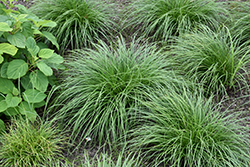It's all about ...
plants

Height: 20 inches
Spread: 24 inches
Sunlight:
![]()
![]()
Hardiness Zone: 4a
Other Names: Prickly Sedge, Muricate Sedge
Description:
A low maintenance and drought tolerant selection that features beautiful arching green foliage; forms slow spreading, dense tufts; excellent addition to borders, rock gardens, or edging around ponds and streams
Ornamental Features
Rough Sedge is primarily valued in the garden for its interestingly mounded form. Its attractive grassy leaves remain forest green in colour throughout the year. The coppery-bronze seed heads are carried on spikes which fade to dark brown over time from mid to late summer.
Landscape Attributes
Rough Sedge is a dense herbaceous evergreen perennial grass with a mounded form. It brings an extremely fine and delicate texture to the garden composition and should be used to full effect.
This is a relatively low maintenance plant, and is best cleaned up in early spring before it resumes active growth for the season. Gardeners should be aware of the following characteristic(s) that may warrant special consideration;
- Spreading
- Self-Seeding
Rough Sedge is recommended for the following landscape applications;
- Mass Planting
- Border Edging
- General Garden Use
- Groundcover
Planting & Growing
Rough Sedge will grow to be about 18 inches tall at maturity, with a spread of 24 inches. Its foliage tends to remain dense right to the ground, not requiring facer plants in front. It grows at a slow rate, and under ideal conditions can be expected to live for approximately 10 years. As an evegreen perennial, this plant will typically keep its form and foliage year-round.
This plant does best in full sun to partial shade. It is very adaptable to both dry and moist locations, and should do just fine under typical garden conditions. It is considered to be drought-tolerant, and thus makes an ideal choice for a low-water garden or xeriscape application. This plant should not require much in the way of fertilizing once established, although it may appreciate a shot of general-purpose fertilizer from time to time early in the growing season. It is not particular as to soil type or pH. It is somewhat tolerant of urban pollution. Consider applying a thick mulch around the root zone in both summer and winter to conserve soil moisture and protect it in exposed locations or colder microclimates. This species is not originally from North America. It can be propagated by division.
This plant is not reliably hardy in our region, and certain restrictions may apply; contact the store for more information.
